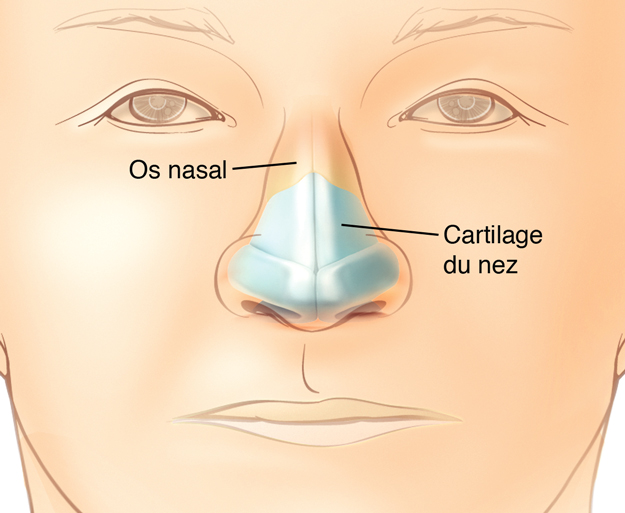
A nasal fracture (broken nose) is a traumatic event characterized by the fracture of one or both nasal bones (it should be noted that the bony structure of the nose is formed by two rather thin bones of roughly rectangular shape; these meet at the midline); in the image below, you can easily see where they are exactly positioned.
Nasal fractures are accidents that affect people who engage in contact sports more often (primarily boxing, but also consider rugby, American football, and soccer), but don’t forget about cycling (the risk of falling is often present) and weightlifting (when practiced without proper equipment).
Other situations in which a nasal fracture can occur include car accidents (the risk is greatly reduced if wearing a seatbelt), disastrous falls onto the ground, fights or altercations, unintentional collisions with very hard objects, etc.
Generally, given the highly exposed position of the nasal structure and the thinness of the nasal bones, nasal fracture is a fairly common injury. A nasal fracture is defined as complete when the fragments separate and incomplete when the bone is cracked but the fragments remain in place. It is estimated that the force required to cause a fracture of the nasal bones is about 15 to 30 kg per square inch.
How do I know if my nose is broken or fractured?
A person suffering from a nasal fracture presents a fairly varied symptomatic picture; local pain, usually very intense, is always present; other commonly present clinical manifestations include swelling of the nose and surrounding areas, epistaxis (nosebleeds), a twisted or otherwise deformed nose, hematomas (both around the nose and under the eyes), mucus discharge from the nostrils, and difficulty breathing.
Nasal fractures can be more or less severe; in some cases, they constitute real medical emergencies and, as such, must be treated as quickly as possible.
When you experience trauma involving your nose and also feel headaches, neck pain, nausea, vomiting, and a sensation of fainting, you should immediately go to the emergency room.
This indication also applies if breathing is particularly difficult, if the nosebleed does not stop, and if clear, watery fluid is draining from the nose.
Complications
Nasal fracture is an event that is not free from complications; for this reason, after a violent facial trauma in which the nose is involved, medical consultation is advisable, even if the situation does not seem serious.
One of the most common complications of a nasal fracture is deviation of the nasal septum, which, depending on its severity, can lead to significant narrowing or even complete closure of one of the two nostrils.
Another complication that is not so rare is septal hematoma; this is an event that occurs as a result of blood clotting that occurs after the traumatic event. The septal hematoma must be drained as it can seriously damage neighboring cartilaginous structures.
In the case of severe breaks caused by significant trauma, a rupture of the nasal cartilage may occur, requiring the intervention of a surgeon.
Diagnosis
In general, the diagnosis of a nasal fracture is fairly straightforward and, in most cases, a physical examination is sufficient, which is performed after administration of local anesthesia (palpation of the traumatized area can be particularly painful).

Broken nose: what to do?
A nasal fracture is often particularly painful, but it does not necessarily have to be too serious. If the injury is minor, you must arm yourself with patience and wait for spontaneous healing. You will obviously need to be careful with maneuvers involving the injured area (even simply washing your face can be particularly painful).
Pain medications and ice applications can help. During nighttime rest, the head should remain elevated.
Things are a bit different in the case of nasal fractures of a certain severity; in these cases, indeed, it is necessary to resort to what is called manual realignment; in practice, the nose bones are put back into position using special instruments; this maneuver is performed under local anesthesia (but, in some particular cases, for example, if the injured person is a child, general anesthesia is used).
The realignment must be performed within one to two weeks at most from the moment of the fracture; it is absolutely necessary to avoid the bones from calcifying; if this happens, it is necessary to resort to nose cosmetic surgery.
Once realignment is done, the broken nose must be protected by a bandage combined with a splint to keep the alignment stable. The nose will remain bandaged and fitted with a splint for about a week.
Have your nose repair surgery in Turkey
As a general rule, to prevent potential bacterial infection, the doctor prescribes antibiotic treatment. About two weeks of rest is needed.
In cases of more severe nasal fractures (or in cases of untimely surgical realignment), surgical intervention is necessary. If the nasal fracture is associated with particularly significant deviation of the nasal septum, septoplasty may also be necessary.
The nose operation is performed under general anesthesia. As this procedure is much more invasive than manual realignment, absolute rest for about two to three weeks is essential.
In rare cases, even if the fracture has been correctly reduced, exuberant bone callus forms on the back of the nose and is perceived externally as a sort of “bump.” This is a phenomenon related to the bone fusion process and, unfortunately, it is neither predictable nor avoidable. In this case, if you want to return to the pre-fracture state, it is necessary to undergo rhinoplasty, for which you will have to wait at least one year after the fracture has healed.

